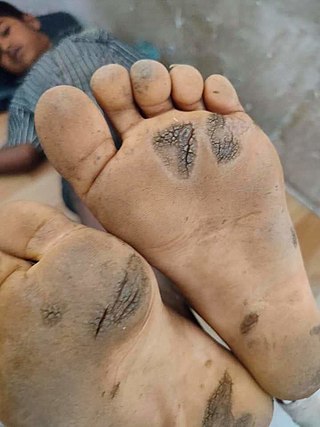
Epidermolytic ichthyosis (EI), is a severe form of dry scaly skin, that initially presents with redness, blisters, erosions, and peeling in a newborn baby. Hyperkeratosis typically develops several months later. Other symptoms include itch, painful fissures, strong body odor, and absence of sweat. Symptoms vary in severity and extent of skin involvement. The two main types are divided into one involving palms and soles and the other without.

Keratin 9 is a protein that in humans is encoded by the KRT9 gene.

Hyperkeratosis is thickening of the stratum corneum, often associated with the presence of an abnormal quantity of keratin, and is usually accompanied by an increase in the granular layer. As the corneum layer normally varies greatly in thickness in different sites, some experience is needed to assess minor degrees of hyperkeratosis.

Meleda disease (MDM) or "mal de Meleda", also called Mljet disease, keratosis palmoplantaris and transgradiens of Siemens, is an extremely rare autosomal recessive congenital skin disorder in which dry, thick patches of skin develop on the soles of the hands and feet, a condition known as palmoplantar hyperkeratosis. Meleda Disease is a skin condition which usually can be identified not long after birth. This is a genetic condition but it is very rare. The hands and feet usually are the first to show signs of the disease but the disease can advance to other parts of the body. Signs of the disease include thickening of the skin, on hands and soles of feet, which can turn red in color. There currently is no cure and treatment is limited, but Acitretin can be used in severe cases.

Keratoderma is a hornlike skin condition.

Dermatopathia pigmentosa reticularis(DPR) is a rare, autosomal dominant congenital disorder that is a form of ectodermal dysplasia. Dermatopathia pigmentosa reticularis is composed of the triad of generalized reticulate hyperpigmentation, noncicatricial alopecia, and onychodystrophy. DPR is a non life-threatening disease that largely affects the skin, hair, and nails. It has also been identified as a keratin disorder. Historically, as of 1992, only 10 cases had been described in world literature; however, due to recent advances in genetic analysis, five additional families studied in 2006 have been added to the short list of confirmed cases.

Pachyonychia congenita is a rare group of autosomal dominant skin disorders that are caused by a mutation in one of five different keratin genes. Pachyonychia congenita is often associated with thickened toenails, plantar keratoderma, and plantar pain.
Ichthyosis hystrix is a group of rare skin disorders in the ichthyosis family of skin disorders characterized by massive hyperkeratosis with an appearance like spiny scales. This term is also used to refer to a type of epidermal nevi with extensive bilateral distribution.

Erythrokeratodermia variabilis is a rare autosomal dominant disorder that usually presents at birth or during the first year of life. To date, it is thought to be caused by mutations in genes encoding for connexin channels proteins in the epidermis, leading to the misregulation of homeostasis in keratinocytes.

Acrokeratoelastoidosis of Costa or Acrokeratoelastoidosis is a hereditary form of marginal keratoderma, and can be defined as a palmoplantar keratoderma. It is distinguished by tiny, firm pearly or warty papules on the sides of the hands and, occasionally, the feet. It is less common than the hereditary type of marginal keratoderma, keratoelastoidosis marginalis.

Corneodermatosseous syndrome is an autosomal dominant condition with onset in infancy, characterized by corneal dystrophy, photophobia, diffuse palmoplantar keratoderma, distal onycholysis, skeletal abnormalities, with brachydactyly, short stature, and medullary narrowing of digits.
Schöpf–Schulz–Passarge syndrome is an autosomal recessive condition with punctate symmetric palmoplantar keratoderma, with the keratoderma and fragility of the nails beginning around age 12. In addition to palmoplantar keratoderma, other symptoms include hypodontia, hypotrichosis, nail dystrophies, and eyelid cysts. Patients may also develop syringofibroadenoma and squamous cell carcinomas.

Acrokeratosis verruciformis is a rare autosomal dominant disorder appearing at birth or in early childhood, characterized by skin lesions that are small, verrucous, flat papules resembling warts along with palmoplantar punctate keratoses and pits. However sporadic forms, whose less than 10 cases have been reported, presents at a later age, usually after the first decade and generally lack palmoplantar keratoses. Whether acrokeratosis verruciformis and Darier disease are related or distinct entities has been controversial, like Darier's disease, it is associated with defects in the ATP2A2 gene. however the specific mutations found in the ATP2A2 gene in acrokeratosis verruciformis have never been found in Darier's disease.
Striate keratodermas are a group of autosomal dominant palmoplantar keratodermas with streaking hyperkeratosis involving the fingers and extending onto the palm of the hand.
Multiple minute digitate hyperkeratosis, also known as digitate keratoses, disseminated spiked hyperkeratosis, familial disseminated piliform hyperkeratosis, and minute aggregate keratosis is a rare cutaneous condition, with about half of cases being familial, inherited in an autosomal dominant fashion, while the other half are sporadic.
Howel–Evans syndrome is an extremely rare condition involving thickening of the skin in the palms of the hands and the soles of the feet (hyperkeratosis). This familial disease is associated with a high lifetime risk of esophageal cancer. For this reason, it is sometimes known as tylosis with oesophageal cancer (TOC).

Focal palmoplantar and gingival keratosis is a rare autosomal dominant disease whose clinical features, and in particular, pathologic alterations and molecular mechanisms remains to be well defined.
Palmoplantar keratoderma with deafness, also known as Palmoplantar keratoderma-deafness syndrome is a rare genetic disorder which is characterized by either focal or diffuse early-onset palmoplantar keratoderma and sensorineural deafness. Transmission is autosomal dominant with incomplete penetrance.







